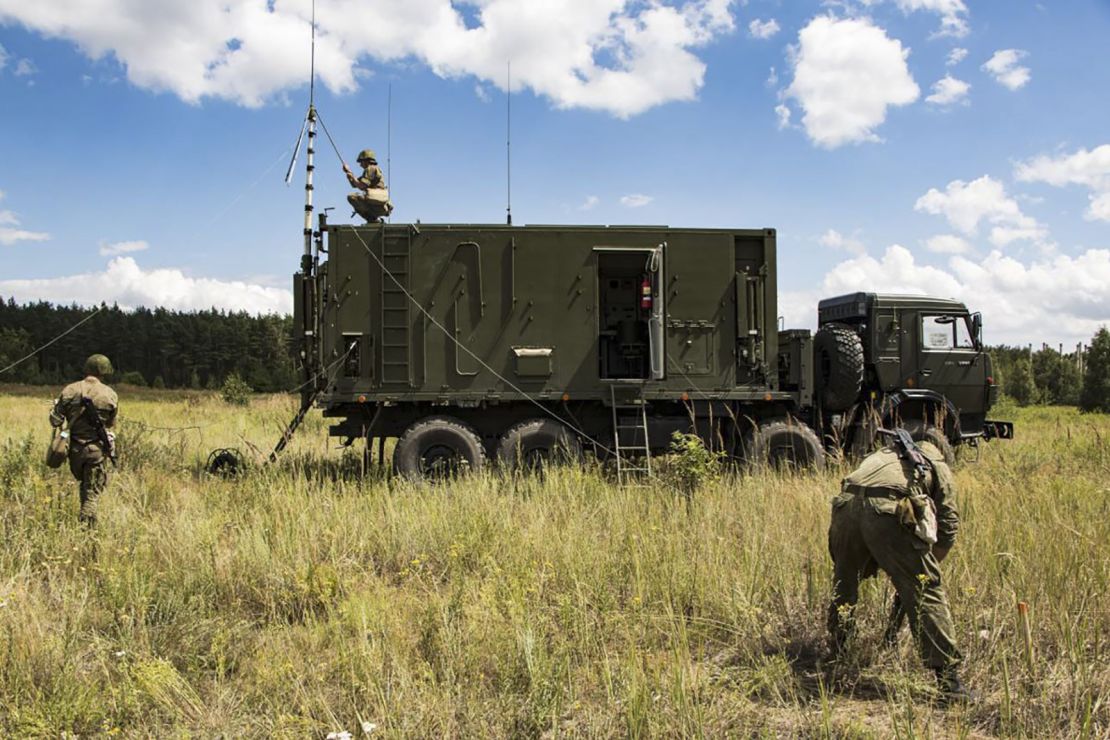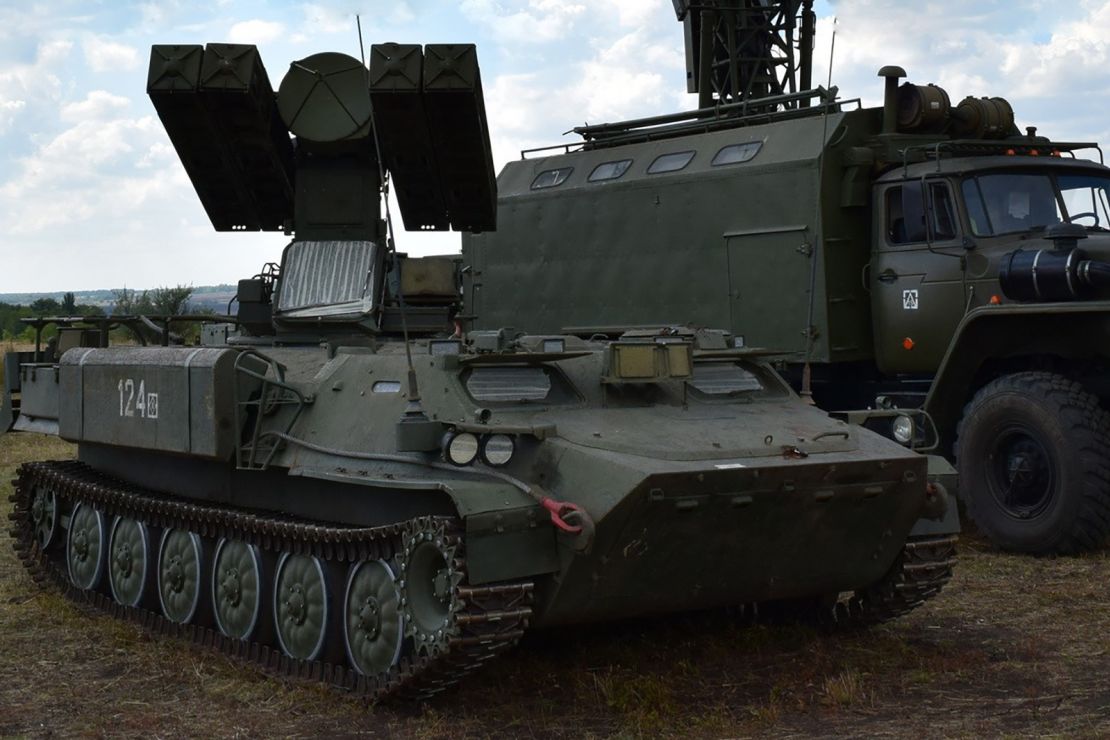In early November, drone video surfaced online appearing to show a targeted strike blowing up three antennas on the roof of an apartment block. The Ukrainian drone commander who posted it claimed to have destroyed a Russian Pole-21 electronic warfare system on the eastern front near Donetsk.
Ukraine is already racing to catch up with Russia when it comes to electronic warfare.
This attack also shows how Kyiv is rushing to destroy Moscow’s technology on the battlefield – a sign of how important it may be for the future of the war.
Electronic warfare, or EW, involves weapons or tactics using the electromagnetic spectrum. It is being employed by both militaries in this conflict, predominantly through electronic jammers that throw off GPS guided targeting systems, causing rockets to miss their targets.
After almost six months of Ukraine’s slow and grinding counteroffensive, it’s clear Russia has not just built up physical defenses but formidable electronic ones, and Ukrainian soldiers on the front lines are having to adapt quickly.

Pavlo Petrychenko, the drone commander with Ukraine’s 59th Motorized Brigade, which carried out the early November strike, says successfully destroying these systems is critical if Ukraine is to liberate more territory. The video he posted on social media is one of a growing number of Ukrainian military and media reports of successful strikes against Pole-21 systems alone, since the summer.
“At the beginning of the conflict, they used electronic warfare to interfere with our communication, our walkie-talkies, radiocommunications, telephones, drones,” he told CNN on a video call from near Avdiivka on the eastern front, the current site of some of the fiercest fighting in the war.

“But when we started to receive foreign equipment, they started to use these systems to suppress our weapons.
“Since (the both US-provided) HIMARS (High Mobility Artillery Rocket System) and Excalibur 155 (an extended range artillery projectile) are guided by satellites, electronic warfare is actively used by (Russia) as one element of the defense against us,” Petrychenko said.
A chink in Ukraine’s NATO-provided armor
And that’s the problem for Ukraine. Russian jammers have turned the technological advantage of Ukraine’s Western-provided arsenal of “smart” – guided – weapons into a vulnerability.
Precision-guided missiles and guided multiple launch rocket systems – such as HIMARS – are by their nature more vulnerable to electronic warfare than unguided weapons because they rely on GPS to hit their targets. Unguided weapons, common in the Soviet-era stockpiles of both Russia and Ukraine, pre-2022, do not.
The Pole-21 system, designed to jam GPS signals to protect Russian assets from incoming drones or missiles, is just one feature of Moscow’s growing electronic arsenal.
Jamming, as well as “spoofing” GPS – a technique which effectively tricks an enemy drone or missile into thinking it’s somewhere else – which also disrupts radar, radio and even cell communications, are all part of the Kremlin’s playbook.

In September, state news agency TASS reported that Russian Prime Minister Mikhail Mishustin told a government meeting that production of key types of military equipment, including EW, had doubled in the first eight months of the year.
Experts and Ukrainian officials also say Russia has now fully integrated electronic warfare with its troops.
Ukraine’s commander-in-chief Valery Zaluzhny wrote in a recent essay that Russia is now mass producing what he calls “trench electronic warfare.”
“The tactical level of the Russian troops is saturated with (this equipment)” and despite equipment losses Moscow still maintains “significant electronic warfare superiority,” Zaluzhny added.
Zaluzhny also singled out American-made Excalibur shells, noting they “have had their capability significantly decreased, since the targeting system (using GPS) is very sensitive to the influence of enemy electronic warfare.”
Pentagon spokesman Maj. Charlie Dietz said that, “while the impact of Russian jamming has been observed” in certain United States-provided systems, including HIMARS rocket launchers, “it has not rendered these systems ineffective.”
Dietz said the department has taken steps to reduce those vulnerabilities, undertaking “substantial efforts to re-engineer and update these systems.” He added that updates are “being implemented as swiftly as possible to counteract the effects of EW jamming.”
From drone army to electronic army
Ukraine said it has been able to increase domestic drone production a hundredfold this year – something that has transformed the battlefield.
The man behind this, Ukraine’s minister of digital transformation, Mykhailo Fedorov, now hopes to repeat that success with electronic warfare – not least because drones are so often the victims of EW.
“We are not only scaling UAV (unmanned aerial vehicles) production, we are scaling EW production too and generally changing the approach to the use of electronic warfare,” Fedorov said in an interview with CNN from Kyiv. “The entire doctrine for using this technology is changing on our side.”
This involves not just integrating electronic warfare as a layer of protection on the battlefield, but doing it smartly.
Fedorov warns against “oversaturating” the battlefield, but instead supports designing EW systems that can be controlled remotely, so they target only enemy equipment.
Otherwise, there’s a real risk that electronic warfare systems can work against you, downing your own drones, Fedorov added.
A November 2022 report from the British think tank Royal United Services Institute suggested that what it calls “electronic fratricide” – accidentally targeting one’s own forces – was such a big problem on the Russian side in the early days of the war that they had to scale back EW efforts to avoid sabotaging their own battlefield communications.
The most important task for now though, Fedorov says, is for Ukraine to acquire the technology to program its drones to target enemy electronic warfare equipment on a large scale.
That would be a game-changer for drone operators like Petrychenko, who admits they are in a game of cat-and-mouse, hunting Russian equipment.

Right now, the best hope they have is that videos, like the one of his early November drone strike, go viral, Petrychenko said. With so many Ukrainian troops on social media, any viral footage like this would act like a handbook, helping them identify Russian antennas on the battlefield.
It’s clear this is changing the game beyond Ukraine.
“I think what you’re seeing play out in Ukraine is very much a glimpse into what modern warfare looks like today,” said Kari Bingen, director of the Aerospace Security Project at think tank Center for Strategic and International Studies and a former principal deputy under secretary for defense at the Pentagon. It’s a future where “electronic warfare capabilities, tactics are integrated into conventional force operations,” she added.
Dietz, the Pentagon spokesman, said the US is “actively evaluating and adapting its strategies” in electronic warfare, and sees it as a “fundamental aspect of contemporary and future military engagements.”
Fedorov said Ukraine is investing directly in electronic warfare, but also following in the footsteps of his drone program by incentivizing domestic production.
And he is open about the fact that Ukraine needs the help of its Western allies, both in terms of equipment and expertise.
“The West has all the technology we need. The question possibly is how to use it, and it is an important question. We need to think about the next technological stage in the war.”
CNN’s Katharina Krebs and Haley Britzky contributed reporting.


